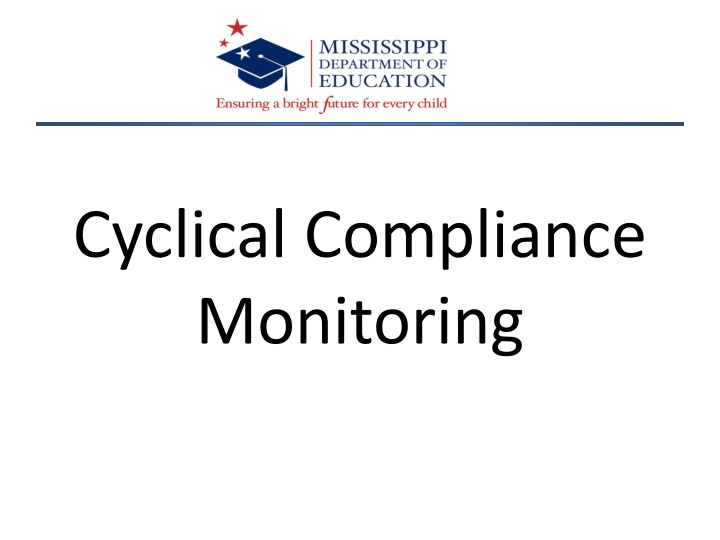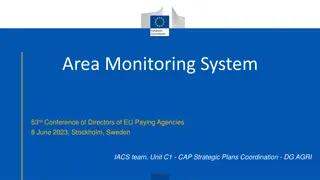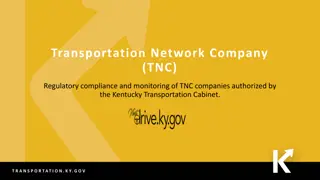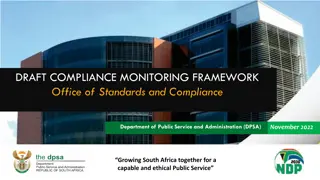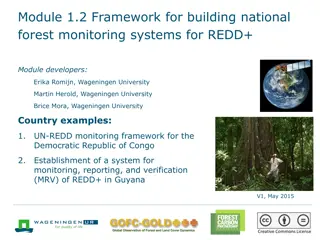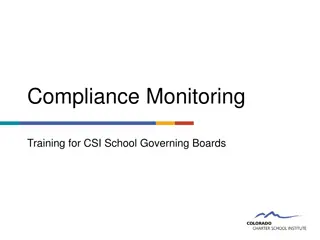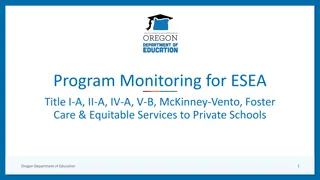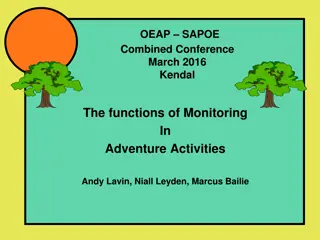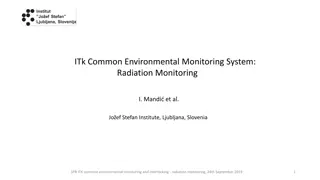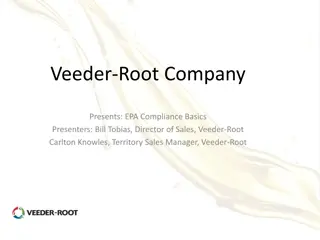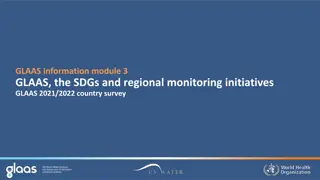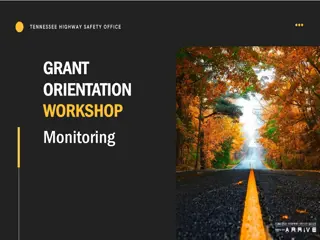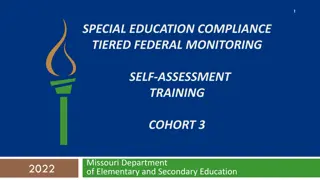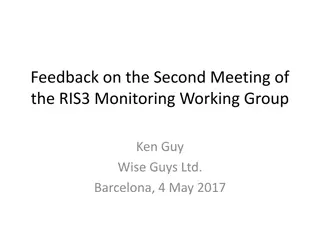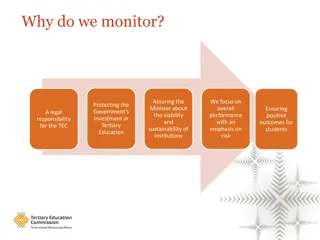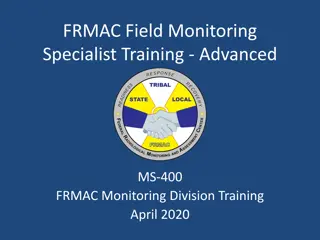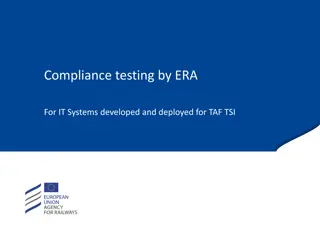Comprehensive Monitoring System for Educational Compliance
This comprehensive monitoring system focuses on improving educational outcomes, meeting program requirements, and ensuring compliance across Local Education Agencies (LEAs) in Mississippi. It encompasses cyclical compliance monitoring, selection criteria based on enrollment groups, and priority areas for examination.
Download Presentation

Please find below an Image/Link to download the presentation.
The content on the website is provided AS IS for your information and personal use only. It may not be sold, licensed, or shared on other websites without obtaining consent from the author.If you encounter any issues during the download, it is possible that the publisher has removed the file from their server.
You are allowed to download the files provided on this website for personal or commercial use, subject to the condition that they are used lawfully. All files are the property of their respective owners.
The content on the website is provided AS IS for your information and personal use only. It may not be sold, licensed, or shared on other websites without obtaining consent from the author.
E N D
Presentation Transcript
Cyclical Compliance Monitoring
Introduction PRIMARY FOCUS OF MONITORING ACTIVITIES Improving educational results and functional outcomes; Meeting critical program requirements related to improving results; and Continuous examination of performance for compliance and results. 2
Introduction Comprehensive Monitoring System Three Components Compliance Indicator Reviews On-Site Reviews Data Fiscal Programming Selective Targeted Reviews 3
Cyclical Compliance Monitoring Focus of the Cyclical Compliance Monitoring: Ensure continuous examination of ALL Local Education Agencies (LEAs) practices in priority areas; Identify noncompliance; Ensure correction in a timely manner; and Ensure consistency with the requirements set forth in OSEP Memorandum 09-02. 5
Cyclical Compliance Monitoring SELECTION CRITERIA: Each LEA in Mississippi is selected for on-site compliance monitoring at least once every four years. LEAs are randomly selected and assigned to a cycle year based on Enrollment Groups (district size by total student enrollment). 6
Cyclical Compliance Monitoring ENROLLMENT GROUPS Group One 5,500 students and up Group Two 3,200 to 5,499 students Group Three 1,700 to 3,199 students Group Four 1,699 students and below 7
Cyclical Compliance Monitoring CYCLICAL SCHEDULE: Thirty-five LEAs have been selected in year one (1) for on-site cyclical monitoring; Thirty-six LEAs selected in year two (2); Thirty-eight LEAs selected in year three (3); and Thirty-seven in year four (4). 8
Cyclical Compliance Monitoring PRIORITY AREAS: Child Find process; Delivery of services and alignment with IEPs; Least restrictive environment (LRE) decisions; Discipline; and Fulfillment of IDEA Part B fiscal requirements. 9
Cyclical Compliance Monitoring PRE-SITE VISIT ACTIVITIES District Notification; OSE request for documentation prior to the scheduled visit (Attachment A); and Documentation to be made available to the monitoring team upon their arrival (Attachment B). 10
Cyclical Compliance Monitoring PRE-SITE VISIT ACTIVITIES (Attachment A) District Policies and Procedures; Pre-referral documentation; Current MSIS roster by school and teacher; Roster for each Language Speech Pathologist; Findings of district Self Review; and Fiscal documentation. 11
Cyclical Compliance Monitoring PRE-SITE VISIT ACTIVITIES (Attachment B) Suspension and expulsion records; List of students with completed FBAs and BIPs; List of students in residential placements; Continuum of placement options available; Documentation of Child Find activities; and List of related service personnel. 12
Cyclical Compliance Monitoring PRE-SITE VISIT ACTIVITIES District s self-review Analyze data in priority areas; Review a number of records utilizing monitoring protocols; Reach valid conclusion based on data on status of special education services; and Discuss results of self-review/findings. 13
Cyclical Compliance Monitoring District s self-review Analyze data in priority areas: Identification process (Indicators 11, 12, 15, 20) Appropriate services and supports (Indicators 4, 5, 6, 12, 15, 20) 14
Cyclical Compliance Monitoring District s self-review Analyze data in priority areas: Appropriate student progress (Indicators 3, 4, 5, 15, 20) 15
Cyclical Compliance Monitoring Review records utilizing monitoring protocols Enrollment Groups # of student records: Group 1 Twenty-five student records; Group 2 Twenty student records; Group 3 Fifteen student records; and Group 4 Thirteen student records 16
Cyclical Compliance Monitoring Results of self-review/findings Reach valid conclusion based on data; and Summarize the district s findings and analysis of data relative to the priority area of focused monitoring. 17
Cyclical Compliance Monitoring ON-SITE ACTIVITIES (DAY 1) Entrance meeting with Superintendent or designee and Special Education Director; Review results of the district s self-review; OSE team will conduct student record reviews using the appropriate monitoring protocols; and Upon completion of Day 1 monitoring, the team will review and consolidate the monitoring information. 18
Cyclical Compliance Monitoring ON-SITE ACTIVITIES (DAY 2) The OSE team will conduct record reviews at the Central Office on Day 2; The team leader will conduct additional interviews if necessary to verify record review findings; The team will review and consolidate information; and The team will meet with the Director of Special Education for an exit meeting. The preliminary list of findings will be discussed. 19
Cyclical Compliance Monitoring POST-SITE VISIT ACTIVITIES Upon completion of the visit, a summary report is developed to summarize the findings from each area of the on-site review; Report identifies findings of individual and systemic noncompliance with IDEA and State Board Policy 7219; OSE will review the final report before submitting the report to the district; Report is sent to the district s Superintendent with copies to the Special Education Director; and The report will address findings of noncompliance, required corrective actions, and recommendations for improvement. 20
Cyclical Compliance Monitoring POST-SITE VISIT ACTIVITIES Correction of noncompliance: The MDE/OSE issues the report of findings to the district within 30 days of the visit; The OSE provides technical assistance and training in identified areas of noncompliance; and All noncompliance must be corrected as soon as possible, but no later than 12 months from the date of identification. 21
Cyclical Compliance Monitoring POST-SITE VISIT ACTIVITIES The district must submit an Improvement Plan; The OSE conducts a follow-up visit (usually within 3 4 months of the initial visit) to ensure correction of all noncompliance in accordance with 09-02 Memorandum; The OSE issues a follow-up report; and Additional follow-up and technical assistance are provided until district corrects all identified noncompliance. 22
Cyclical Compliance Monitoring MONITORING PROTOCOLS Appropriate Identification Process; Appropriate Services and Supports; and Appropriate Student Progress. 23
Cyclical Compliance Monitoring Appropriate Identification Process: Overarching Analysis Question: Does the district implement appropriate identification procedures and practices to ensure that ALL students suspected of having a disability receive a special education evaluation and services, if appropriate? 24
Cyclical Compliance Monitoring Appropriate Student Progress: Overarching Analysis Question: Are students with disabilities making appropriate progress with the general curriculum as compared to grade-level standards and expectations? 25
Cyclical Compliance Monitoring Appropriate Services and Supports: Overarching Analysis Question: Are appropriate procedures in place to ensure that students with disabilities receive FAPE in the LRE to access the general curriculum? 26
Cyclical Compliance Monitoring Fulfillment of IDEA Part B fiscal requirements: Overarching Analysis Question: How does the district align fiscal funds to appropriately meet needs? 27
2014 2015 Cyclical Compliance Monitoring CHILD FIND MISSISSIPPI DEPARTMENT OF EDUCATION OFFICE OF SPECIAL EDUCATION ACCOUNTABILITY STANDARD 17.4 ON-SITE MONITORING RECORD REVIEW FORM Record Review Item CF-1 Regulation 34 CFR or SBP 7219 300.111(a) 300.111(c) 300.131(a) Record Review Question Potential Source(s) of Documentation Compliant Evidence Does the public agency have Child Find (CF) policies and procedures in effect, including those addressing special populations, and that specifically State requests for an evaluation may not be limited by the number per year or time of year a request is received? Special populations include: Homeless children, Wards of the State, Private school children, Children advancing from grade to grade, and Highly mobile and/or migrant children. CF policies and procedures CF policies are consistent with State Board Policy 7219 and IDEA. CF procedures provide sufficient guidance to implement CF policies. CF procedures are in effect to address each of the special populations. CF activities addressed in policies and procedures are not limited by a total number per year. CF activities addressed in policies and procedures address handling CF at times when school is not in session. CF procedures occur appropriately as written. CF policies or procedures are non-existent, insufficient, or inconsistent with SBP 7219/IDEA. CF procedures do not sufficiently address the following special populations: Homeless children Wards of the State Private school children Children advancing from grade to grade CF policies (e.g., policy manual) CF procedures (e.g., procedures manual) Any forms for implementing CF procedures YES CHILD FIND NO 28
2014 2015 MISSISSIPPI DEPARTMENT OF EDUCATION OFFICE OF SPECIAL EDUCATION ACCOUNTABILITY STANDARD 17.4 ON-SITE MONITORING RECORD REVIEW FORM Cyclical Compliance Monitoring CHILD FIND Regulation 34 CFR or SBP 7219 300.307 and State Board Policy 4300 (Tiered Instructional Model) Record Review Item Record Review Question Potential Source(s) of Documentation Compliant Evidence CF-3 Does the district provide scientific research-based interventions to resolve concerns for any school-age child who is performing below grade-level standards? *Initial Evaluation Only The record shows evidence of scientific research-based intervention data and provides a summary of the interventions that have been implemented prior to referral or during the evaluation process. * Teacher Support Team Documentation * Data from interventions, * Evaluation Team Report * Referral Form, * Prior Written Notice. YES The student record contains no evidence that interventions were provided to the child. NO Evaluation is not an initial evaluation or transfer from previous LEA. CHILD FIND NA CF-4 300.301- 300.304 Did the district proceed with a referral for a comprehensive evaluation for a child with a suspected disability without delaying referral because the child has not participated in an RtI process? *Initial Evaluation Only The record shows that the Teacher Support Team did not require the child to participate in the RtI process when the child was suspected of having a disability under 34 CFR 300.8. * Teacher Support Team Documentation * Evaluation Team Report * Referral Form YES The student record contains information indicating that the LEA required the child to participate in the RtI process. NO NA The Teacher Support Team did not suspect the child of having an obvious disability. 29
2014 2015 MISSISSIPPI DEPARTMENT OF EDUCATION OFFICE OF SPECIAL EDUCATION ACCOUNTABILITY STANDARD 17.4 ON-SITE MONITORING RECORD REVIEW FORM Cyclical Compliance Monitoring CHILD FIND Regulation 34 CFR or SBP 7219 300.301(b)(1) Record Review Item Record Review Question Potential Source(s) of Documentation Compliant Evidence CF-5 Does the public agency have a process for receiving and documenting verbal and written requests for a comprehensive evaluation from (a) parents, (b) public agencies, and (c) Teacher Support Teams (TST)? Is there evidence that the public agency consistently follows this process? Does the public agency invite parents and others with knowledge of the child to participate in a Multidisciplinary Evaluation Team (MET) meeting to determine the need for comprehensive evaluations and hold MET meetings with CF procedures are followed consistently for receiving and documenting written and verbal requests for a comprehensive evaluation from (a) parents, (b) public agencies, and (c) TSTs. CF procedures for documenting a written or verbal request are non- existent, insufficient, or inconsistent with SBP 7219. CF procedures for documenting a written or verbal request are not followed resulting in a failure to document requests received and/or responding to requests in a timely manner. MET meetings occur within 14 calendar days of receiving requests for comprehensive evaluations. A decision is made about whether or not to proceed with a comprehensive evaluation for every MET meeting held. All of the appropriate members, including parents and others knowledgeable of the child, are invited to participate in the MET meetings using available methods. CF procedures (e.g., procedures manual) CF referral forms YES CHILD FIND NO CF-6 300.301(b)(1)(i) 300.301(b)(1)(ii) 300.301(b)(1)(iii) 300.131(e) 300.306(a)(1) 300.308 300.309(a) Special Education Eligibility Determination Guidelines Documentation of TST Referrals with dates Documentation of other CF referrals with dates Documentation of invitations to MET meetings Records of MET meetings with dates of the meetings and lists of participants YES 30
2014 2015 Cyclical Compliance Monitoring CHILD FIND MISSISSIPPI DEPARTMENT OF EDUCATION OFFICE OF SPECIAL EDUCATION ACCOUNTABILITY STANDARD 17.4 ON-SITE MONITORING RECORD REVIEW FORM Record Review Item Regulation 34 CFR or SBP 7219 300.301(b)(1)(i) 300.301(b)(1)(ii) 300.301(b)(1)(iii) 300.131(e) 300.306(a)(1) 300.308 300.309(a) Special Education Eligibility Determination Guidelines Record Review Question Compliant Evidence Potential Source(s) of Documentation CF-6 (cont.) the participation of appropriate members within 14 calendar days of receiving requests? The MET consists of a team of qualified professionals including: 1. The child s parent; 2. Qualified professionals MET members may participate by: 1. Being present for the meeting; 2. Using an alternate technology (e.g., phone conference); or 3. Submitting written information and opinions. All appropriate members participate in the MET meetings using available methods. Documentation of MET members signing eligibility report to demonstrate participation in MET. The public agency fails to invite appropriate members to participate in the MET meeting: Parents Qualified professionals: special education teachers regular education teachers school psychologists/psychometrists speech-language pathologists/therapists school health nurses NO CHILD FIND 31
Cyclical Compliance Monitoring MISSISSIPPI DEPARTMENT OF EDUCATION OFFICE OF SPECIAL EDUCATION ACCOUNTABILITY STANDARD 17.4 ON-SITE MONITORING RECORD REVIEW FORM DELIVERY OF SERVICES 2014 2015 Record Review Item DS-1 Regulation 34 CFR or SBP 7219 300.645 Record Review Question Potential Source(s) of Documentation Compliant Evidence Did the student have an IEP in place on the most recent December child count? Current or prior IEP that had effective dates encompassing December 1. IEP includes IEP team signatures and no evidence in file that parent revoked consent prior to December 1. IEP Indicator 13 Checklist The child had an IEP in effect on December 1. YES DELIVERY OF SERVICES The child did not have an IEP in effect on December 1. NO DS-2 300.320(b) 300.324(c) If the student is 14 or older, provides appropriate transition services The transition planning elements of the IEP are compliant with criteria established on the National Secondary Transition Technical Assistance Center (NSTTAC) Indicator 13 Checklist (See addendum.). Transition planning on the IEP is noncompliant with one or more of the 8 required Federal elements outlined on the checklist (See addendum). The child is not 14 or above, or the IEP reported in MSIS is the current IEP. YES NO NA 32
Cyclical Compliance Monitoring Record Review Item DS-3 Regulation 34 CFR or SBP 7219 300.320(a)(1) 300.324(a)(1) Record Review Question Potential Source(s) of Documentation Compliant Evidence Does the IEP include Present Levels of Academic Achievement and Functional Performance (PLAAFP) that address the needs of the student? School-age (PLAAFP) PLAAFP must include the following information as it relates to each goal: Summary of current daily academic/behavior and/or functional performance (strengths and needs); Baseline data provided for developing a measurable goal. (e.g. ATR results, if current; formative, curriculum-based, transition, functional behavior assessments). Preschool IEP describes how the disability affects the child s participation in appropriate activities to access, participate, and progress in the general curriculum and/or participation in developmentally appropriate activities. Additional for Preschool PLAAFP relate to the child s developmental domains, functional performance and pre-academic skills. Functional skills are: integration of cognitive, language, and motor skills for the child to demonstrate positive social- emotional skills, acquisition and use of knowledge and skills; and to take care of personal needs (self-help). IEP (Present Levels of Academic Achievement and Functional Performance) DELIVERY OF SERVICES YES 33
Cyclical Compliance Monitoring ON-SITE MONITORING RECORD REVIEW FORM DELIVERY OF SERVICES 2014 2015 MISSISSIPPI DEPARTMENT OF EDUCATION OFFICE OF SPECIAL EDUCATION ACCOUNTABILITY STANDARD 17.4 Record Review Item DS-3 (cont.) Regulation 34 CFR or SBP 7219 300.320(a)(1) Record Review Question Potential Source(s) of Documentation Compliant Evidence Present levels of performance do not provide detailed and targeted summary of current daily academic/behavior and/or functional performance related to the development of measurable goals. NO DS-4 300.320(a)(2)(i) (A) 300.324(b)(1) Do annual goals address the child s academic area(s) of need? There is alignment between the academic needs identified in the IEP and the annual goals or evidence in the IEP that the IEP Committee, based on the severity of needs, decided to prioritize addressing the needs. Annual goals fail to address the child s academic needs identified in the IEP. Academic needs were not identified at this time. IEP Annual Goals YES DELIVERY OF SERVICES NO NA Do annual goals address the child s functional area(s) of need? There is alignment between the functional needs identified in the IEP and the annual goals. Functional means nonacademic, as in routine activities of everyday living. The annual goals fail to reasonably address functional area(s) of need identified in the IEP. Functional needs were not identified at this time. Annual Goals DS-5 300.320(a)(2)(i) (A) 300.324(b) YES NO NA 34
Cyclical Compliance Monitoring Record Review Item DS-7 Regulation 34 CFR or SBP 7219 300.320(a)(4) 300.39(b)(3) Record Review Question Potential Source(s) of Documentation Compliant Evidence Does the IEP contain a statement of specially- designedinstruction that addresses the needs of the child and supports annual goals to enable the child i. To advance appropriately toward attaining the annual goals; ii. To be involved in and make progress in the general education curriculum. The IEP specifically identifies the provision of specially-designed instruction and describes the nature of the instruction that aligns with the needs of the child and supports the achievement of annual goals. Definition 300.39 (b)(3) Specially-designed instructionmeans adapting, as appropriate to the needs of an eligible child under this part, the content, methodology, or delivery of instructionor the child is receiving related services that the IEP Committee has determined is specially-designed instruction; i.e. only related services listed on the IEP. Instruction in organization skills to include use of daily checklists and academic subject organizers. IEP Description(s) of Specially-Designed Instruction DELIVERY OF SERVICES YES The IEP does not specifically identify the provision of specially-designed instruction and does not describe the nature of the instruction that aligns with the needs of the child and supports the achievement of annual goals. NO 35
Cyclical Compliance Monitoring ACCOUNTABILITY STANDARD 17.4 ON-SITE MONITORING RECORD REVIEW FORM DISCIPLINE Record Review Item SBP 7219 300.530(e)(1) 300.536 district conduct a manifestation determination to determine the relationship of the child s behavior of concern to the child s disability? DIS-2 300.530(e)(1) 300.530(g) 300.536 within 10 school days of the district s decision to change the placement of a child with a disability? (Change of placement is disciplinary removal of a child for violation of student code of conduct and removal if for more than ten consecutive school days or series of removals constitute a pattern.) 2014 2015 MISSISSIPPI DEPARTMENT OF EDUCATION OFFICE OF SPECIAL EDUCATION Regulation 34 CFR or Record Review Question Potential Source(s) of Documentation Compliant Evidence If necessary, did the * Manifestation Determination Review Form DIS-1 A Manifestation Determination Review Form was completed by the team. YES A Manifestation Determination Review Form was not completed by the team. NO Was the manifestation determination conducted The date of the manifestation determination review is not more than 10 school days from the date of the decision to change the placement of a child with a disability through a school suspension or expulsion. The date of the manifestation determination review is more than 10 school days from the date of the decision to change the placement of the child with a disability through a suspension or expulsion. Special Circumstances: School personnel may remove a student to an interim alternative educational setting for not more than forty-five (45) school days without regard to whether the behavior is determined to be a manifestation of the child s disability for possession of a weapon, possesses or * Student discipline record documenting cumulative days of out-of-school suspension or expulsion, from which the manifestation determination review timeline can be calculated. DISCIIPLINE YES NO 36
Cyclical Compliance Monitoring ACCOUNTABILITY STANDARD 17.4 ON-SITE MONITORING RECORD REVIEW FORM DISCIPLINE 2014 2015 MISSISSIPPI DEPARTMENT OF EDUCATION OFFICE OF SPECIAL EDUCATION Record Review Item Regulation 34 CFR or SBP 7219 Record Review Question Potential Source(s) of Documentation Compliant Evidence DIS-2 (cont.) DIS-3 uses illegal drugs, or inflicts serious bodily injury. There is evidence regarding the provision of educational services following the tenth day of removals. There is evidence regarding the offer to provide educational services following the tenth day of removal, but the child did not participate in the services. There is no evidence documenting the provision of educational services following the tenth day of removals. The child did not receive educational services. 300.530(b)(2) * Attendance Records * Service Provider Logs * Revisions to IEP to discuss change in placement If required, did the district continue to provide services to a student after he or she has been removed from his or her current placement for 10 school days in the same school year, during any subsequent days of removal? YES DISCIPLINE * Student discipline records documenting cumulative days of out-of-school suspension or expulsion from which the manifestation determination review timeline can be calculated. * Functional Behavioral Assessment NO 300.530(c) 300.530(d) 300.530(f)(1) (i)(ii) 300.530(g) An FBA is included in the student s file. The FBA meets the requirements of SBP 300.530(d). An FBA is not included in the student s file. DIS-4 YES 37
Cyclical Compliance Monitoring ACCOUNTABILITY STANDARD 17.4 ON-SITE MONITORING RECORD REVIEW FORM DISCIPLINE 2014 2015 MISSISSIPPI DEPARTMENT OF EDUCATION OFFICE OF SPECIAL EDUCATION Record Review Item DIS-4 (cont.) Regulation 34 CFR or SBP 7219 300.530(c) 300.530(d) 300.530(f)(1) (i)(ii) 300.530(g) Record Review Question Potential Source(s) of Documentation Compliant Evidence Did the district conduct a functional behavioral assessment (FBA) after the manifestation determination? (Unless the district conducted the FBA before the behavior that resulted in the change in placement.) Disciplinary change of placement that would exceed ten school days is determined not to be a manifestation of the child s disability. Disciplinary change of placement for a violation of a code of conduct to an interim alternative educational setting for not more than forty-five school days for weapons, drugs or serious bodily injury. The FBA was conducted, but it does not meet the requirements of SBP 300.530(d). The team determined that the conduct was not a manifestation of the student s disability. A BIP is included in the student s file. The BIP meets the requirements of SBP 300.530(d). A BIP is not included in the student s file. The BIP is included, but it does not meet the requirements of SBP 300.530(d). The team determined that the conduct was not a manifestation of the student s disability. NO DISCIPLINE NA DIS-5 300.530(d) 300.530(f)(1) (i)(ii) Did the district develop a behavioral intervention plan (BIP) for the child as a result of the FBA? OR If the BIP had already been developed, did the district review the BIP after the manifestation determination and modify it as necessary to address the child s behavior? * Behavioral Intervention Plan YES NO NA 38
Cyclical Compliance Monitoring ACCOUNTABILITY STANDARD 17.4 ON-SITE MONITORING RECORD REVIEW FORM LEAST RESTRICTIVE ENVIRONMENT (LRE) Record Review Item SBP 7219 LRE-1 300.114(a)(1) Does the public agency have in effect policies and procedures to ensure LRE requirements are met? 2014 2015 MISSISSIPPI DEPARTMENT OF EDUCATION OFFICE OF SPECIAL EDUCATION Regulation 34 CFR or Record Review Question Potential Source(s) of Documentation Compliant Evidence The public agency has policies and procedures for LRE that ensure: (1) To the maximum extent appropriate, children with disabilities, including children in public or private institutions or other care facilities, are educated with children who are nondisabled; and (2) Special classes, separate schooling, or other removal of children with disabilities from the general education environment occurs only if the nature of the severity of the disability is such that education in general education classes with the use of supplementary aids and services cannot be achieved satisfactorily. LRE policies or procedures are non- existent, insufficient, or inconsistent with SBP 7219/IDEA. Students with disabilities have been suspended or expelled for more than 10 days and do not have access to the general education curriculum. No accommodations or modifications are listed for the general education classroom. IEP Special Education and Related Services Section Description of Specially-Designed Services Special Considerations Section Placement Consideration and LRE Determinations LEAST RESTRICTIVE ENVIRONMENT (LRE) YES NO 39
Cyclical Compliance Monitoring 2014 2015 MISSISSIPPI DEPARTMENT OF EDUCATION OFFICE OF SPECIAL EDUCATION ACCOUNTABILITY STANDARD 17.4 ON-SITE MONITORING RECORD REVIEW FORM LEAST RESTRICTIVE ENVIRONMENT (LRE) Record Review Item SBP 7219 LRE-2 300.115(a)(b) Does the public agency ensure that a continuum of alternative placements is available to meet the needs of children with disabilities for special education and related services? Regulation 34 CFR or Record Review Question Potential Source(s) of Documentation Compliant Evidence The public agency has a documented Continuum of Alternative Placements including instruction in: General Education Special Classes Special Schools Child s home Hospitals or institutions Make provisions for supplementary services (such as resource room or itinerant instruction) to be provided in conjunction with general education class placement. Provide access to general State-wide and district-wide assessment programs, with appropriate accommodations, where necessary. The public agency does not provide a Continuum of Alternative Placements to meet the needs of children with disabilities. No provision for supplementary services to be provided in conjunction with general education placement. IEP Special Education and Related Services Section Description of Specially-Designed Services Special Considerations Section Placement Consideration and LRE Determinations LEAST RESTRICTIVE ENVIRONMENT (LRE) YES NO 40
2014 2015 Cyclical Compliance Monitoring LEAST RESTRICTIVE ENVIRONMENT (LRE) MISSISSIPPI DEPARTMENT OF EDUCATION OFFICE OF SPECIAL EDUCATION ACCOUNTABILITY STANDARD 17.4 ON-SITE MONITORING RECORD REVIEW FORM Record Review Item LRE-4 (cont.) Regulation 34 CFR or SBP 7219 300.116(b) Record Review Question Potential Source(s) of Documentation Compliant Evidence these regulations. The child s placement - Is determined at least annually; Is based on the child s IEP; Is a close as possible to the child s home; and Is educated in the school that he or she would attend if nondisabled, unless IEP requires another arrangement. Does the IEP identify assistive technology to enable the child to be involved in and make progress in the general education curriculum? Definition(s) 300.5 Assistive Technology Device: any device item, piece of equipment, or product system, whether acquired commercially off the Special Consideration Section Is educated in the school that he or she would attend if nondisabled, unless IEP requires another arrangement. Placement Consideration and LRE Determinations Placement decisions are not made in conformity with LRE provisions and the child s placement Is not determined at least annually; Is not based on the child s IEP; Is not as close as possible to the child s home; and Is not educated in the school that he or she would attend if nondisabled. The IEP includes identified assistive technology services the child needs. Assistive technology services were identified by the IEP Committee, but not included on the IEP or the frequency of the assistive technology services was listed as: as needed , at the discretion of the teacher , or as requested by student . LEAST RESTRICTIVE ENVIRONMENT (LRE) NO 300.324(a)(2)(v) LRE-5 IEP Special Education and Related Services Section Description of Specially-Designed Services-Assistive Technology YES NO 41
Cyclical Compliance Monitoring Timeline: First Semester: Early November 2014 Second Semester: January-April 2015 42
Data and Fiscal Management 43
On-Site Activities Conduct an Entrance meeting Discuss the district s fiscal process/procedures Review documents Conduct a random inventory review Conduct an Exit briefing 44
Top Ten Findings 1. Time sheets/Semi-Annual Certification forms not available and/or not signed by employee and/or supervisor 2. Equipment not on the Asset List 3. Equipment not tagged and funding source not indicated 4. Purchasing of equipment not approved or deleted from Project Application 5. Invalid or no contracts for contractual services 45
Top Ten Findings 6. Asset Listing does not indicate description of item, serial number or location 7. Equipment not properly hand receipted 8. Equipment not being used for its intended purpose 9. Unauthorized use of IDEA funds 10. Equipment purchased with IDEA funds used in general education classroom 46
FISCAL PROCESS Selected LEAs will be required to provide: Fiscal Policy and Procedures Fixed Asset Listing by location History Transaction Listing Employee Payroll Listing Purchase orders Semi-Annual Certification forms Personnel Activity Report (PAR) 47
FISCAL AIDS In preparation for the visit the following will be posted to the webpage: Fiscal Monitoring Instrument Top Ten (10) findings Tips to prepare for the visit 48
Monitoring Instrument District Name: District Code #: Date of Site Visit: Team Member: Policy, Regs, Law Document Documentation Review: Source: Comments: Findings: IDEA Part B and Preschool General Questions 1 Obtain and review the grant award/application to identify activities approved, this includes approved amendments. IDEA grant funds are to pay for the excess cost of students with disabilities on a cost reimbursement basis. Monies drawn down should be for reimbursement of allowable items listed in the approved application. 2 Does the LEA program budget reflect the approved IDEA application? Have initial award budgets been amended? 3 What is the process for determining that expenditures are allowable and to be charged to the IDEA grant? 4 Were IDEA funds used for private school students with disabilities? Are the number of private school students submitted for state funding documented? 5 Were IDEA funds used to reimburse expenses prior to the release of funds? 6 Does the LEA anticipate that funds awarded will be expended prior to the end of the award period? 7 Is there a published method for public & employee reporting of fraud, waste and abuse? Are there existing procedures for investigating/substantiating suspected/reported instances? 8 How does the entity ensure that a vendor has not been excluded or disqualified from covered transactions? 34 CFR 300.200 34 CFR 300.201 34 CFR 300.220 34 CFR 300.228 34 CFR 300.705 Circular A-87 34 CFR 300.200 34 CFR 300.201 34 CFR 300.202 EDGAR 80.22 34 CFR 300.133 EDGAR, 76.708 EDGAR, 76.709 EDGAR, 76.710 Whistle Blower Protection Enhancement Act of 2007 EDGAR, 85 49
Monitoring Instrument Maintenance of Effort 9 Does the LEA meet the Maintenance of Effort (MOE) requirement, and is there documentation to substantiate? What procedures does the LEA perform to periodically monitor compliance with the MOE requirement? MOE must be maintained, supplement not supplant applies. If MOE is not maintained is there documented release from the requirement by the SEA on file? 10 Does the LEA have on file the calculations for excess costs to demonstrate that the LEA has spent at least the minimum average for education of children with disabilities before Part B funds are used? Cash Request 11 Review the most recent cash requests and compare to accounting records to verify that grant expenditures reconcile to the request and the receipt of payment is recorded as IDEA funds received. 34 CFR 300.203 34 CFR 300.204 34 CFR 300.205 Appendix A to Part 300 34 CFR 300.16 Circular A-133;CMIA; EDGAR, 80.20(b)(7); EDGAR, 74.21; EDGAR, 74.22; EDGAR, 80.20; EDGAR, 80.21 12 Who is responsible for approving requests for cash? Are requests for cash made on a reimbursement basis and not based on anticipated costs? CMIA , 1990 (Cash Management Improvement Act of 1990); EDGAR, 74.22(a); EDGAR, 80.21(b) EDGAR, 74.22(a); EDGAR, 80.21(b) 13 Is the selected cash request drawn based on reimbursement of expenditures and meets the 72 hour disbursement requirements? 14 Did the LEA earn interest on funds drawn for actual expenditures? EDGAR, 80.21(h)(i) 50
